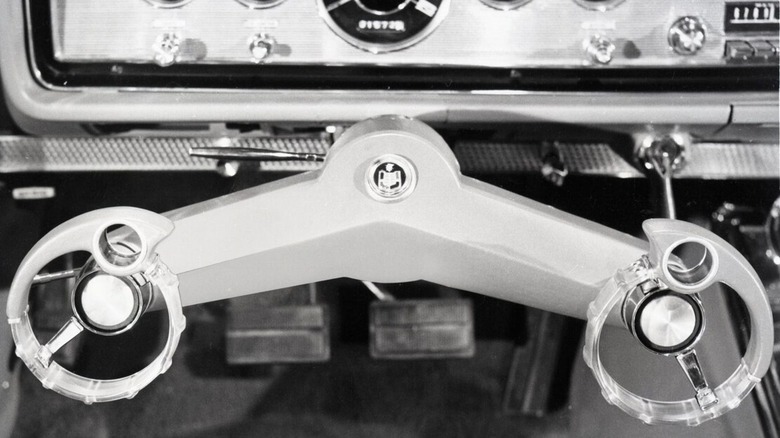This Futuristic Steering Wheel Concept Was Designed By An Actual Rocket Scientist
The future looked wild to those who lived in the era when photographs and even televisions were only available in black and white. Many people through the decades thought we'd be zipping around in flying cars sooner rather than later. But here we are twenty-one years beyond Stanley Kubrik's fanciful Space Odyssey. We haven't cracked the code on driverless vehicles, let alone putting them into the air like we were George Jetson (who ironically was "born" in the year 2022).
Back in 1965, however, the Ford Motor Company came up with a crazy twist — pun intended — for an existing piece of standard equipment. Twenty-four years earlier, Henry Ford predicted: that "a combination of airplane and motorcar" was coming. Perhaps because the airborne auto was still a fantasy, the company was determined to kick start the push towards making this dream a reality. Or maybe it was because the country was enthralled with NASA's fervent attempts to get men to the moon.
Whatever the inspiration, Ford began march toward a futuristic flying jalopy by tackling something relatively small. It hired aerospace engineer Robert J. Rumpf to redesign the humble circular steering wheel. And what he came up with was indeed far out.
The ex-missile engineer, who admittedly knew nothing about automobiles, created what is known as the Wrist-Twist Instant Steering System. The end product looked like the middle part of a regular steering wheel with the circular "wheel" part removed. A 5-inch plastic ring that worked like a big dial was attached to each end of the remaining stalk. It looked similar to a control yoke you might find in an airplane (or a spaceship).
Ford tried to dial up the fun of driving
The car would change directions by turning the dials, which used roller chains attached to the central steering column to transmit commands. Both rings worked in unison, so the driver could use one or both to steer the vehicle. Rumpf designed the "Wrist-Twist" so the sprocket ratios could be adjusted to change the steering ratio, be tilted up and down like any regular wheel, and quickly swapped with a car's existing steering controls.
It was a simple concept with some benefits. First, eliminating the "wheel" portion gave the driver a better view of the gauges on the instrument panel and provided a better line of sight down the road. Additionally, doing away with the hard "wheel" obstruction removed the hazard of hitting one's head during an accident in a time before airbags.
One drawback was that power-assisted steering needed a hydraulic pump to work correctly. If that failed, you could still muscle a conventional steering wheel enough to pull over the vehicle. That wasn't the case with the smaller dials on the "Wrist-Twist" system. There's insufficient leverage to crank those rings and get the tires to turn. However, Rumpf tackled this problem by creating a secondary power system that kicked in if the engine stopped or the hydraulic pump failed, per MotorTrend.
Based on test drives performed in 1965, some 200 men and women said that most aspects of the Wrist-Twist system were "excellent" (via MotorTrend). At the time, Ford felt the system was a complete success, yet it never went into total production. A 1968 issue of Popular Mechanics included a blurb saying it was "still alive and kicking," but after that ... it vanished into oblivion. Rumpf, however accumulated 15 U.S. patents, primarily for vehicle safety (via MacsMotorCity).
